fuel type TOYOTA SEQUOIA 2011 2.G Owners Manual
[x] Cancel search | Manufacturer: TOYOTA, Model Year: 2011, Model line: SEQUOIA, Model: TOYOTA SEQUOIA 2011 2.GPages: 688, PDF Size: 14.76 MB
Page 2 of 688
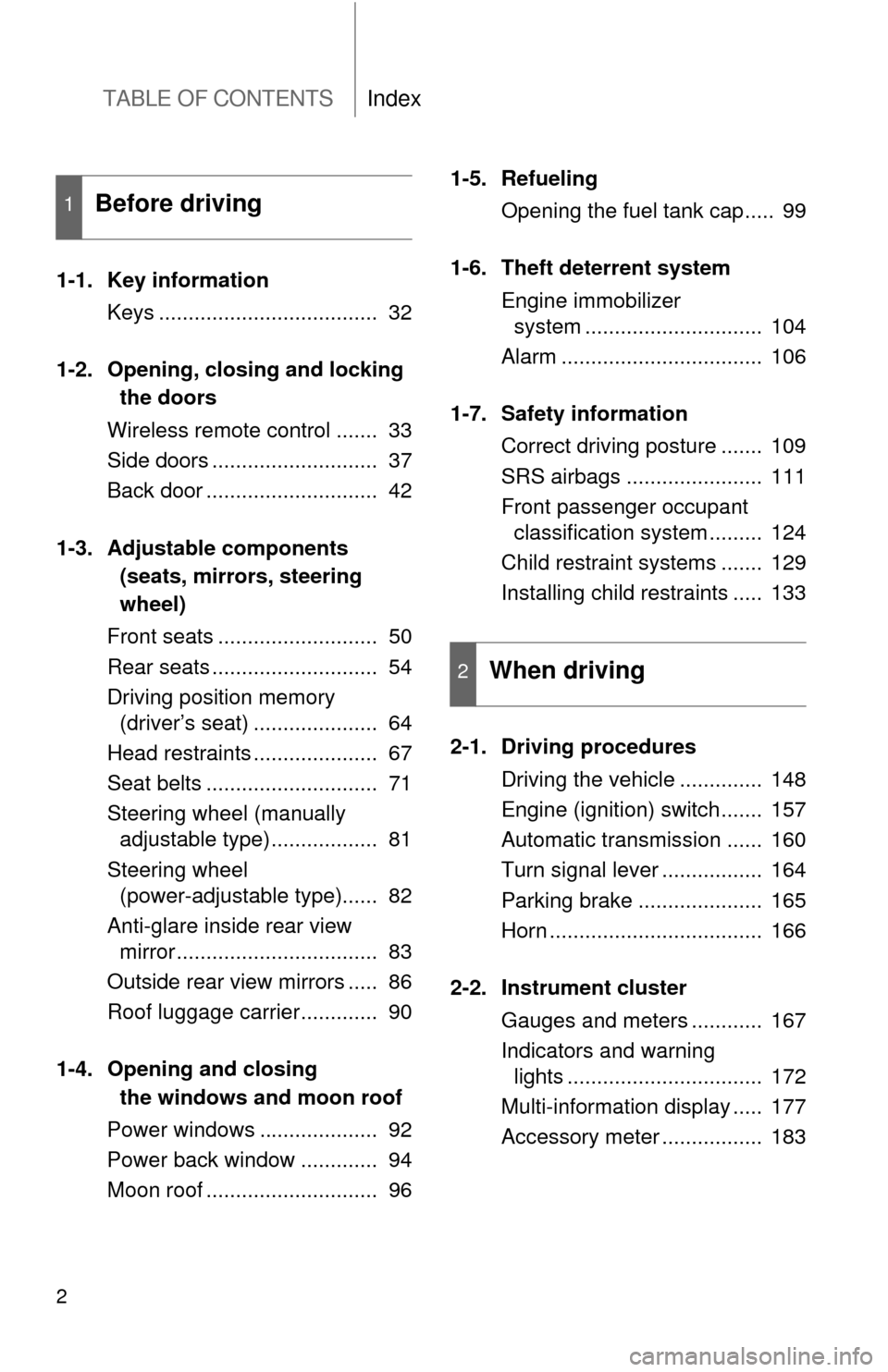
TABLE OF CONTENTSIndex
2
1-1. Key informationKeys ..................................... 32
1-2. Opening, closing and locking the doors
Wireless remote control ....... 33
Side doors ............................ 37
Back door ............................. 42
1-3. Adjustable components (seats, mirrors, steering
wheel)
Front seats ........................... 50
Rear seats ............................ 54
Driving position memory (driver’s seat) ..................... 64
Head restraints ..................... 67
Seat belts ............................. 71
Steering wheel (manually adjustable type) .................. 81
Steering wheel (power-adjustable type)...... 82
Anti-glare inside rear view mirror .................................. 83
Outside rear view mirrors ..... 86
Roof luggage carrier............. 90
1-4. Opening and closing the windows and moon roof
Power windows .................... 92
Power back window ............. 94
Moon roof ............................. 96 1-5. Refueling
Opening the fuel tank cap..... 99
1-6. Theft deterrent system Engine immobilizer system .............................. 104
Alarm .................................. 106
1-7. Safety information Correct driving posture ....... 109
SRS airbags ....................... 111
Front passenger occupant classification system ......... 124
Child restraint systems ....... 129
Installing child restraints ..... 133
2-1. Driving procedures Driving the vehicle .............. 148
Engine (ignition) switch....... 157
Automatic transmission ...... 160
Turn signal lever ................. 164
Parking brake ..................... 165
Horn .................................... 166
2-2. Instrument cluster Gauges and meters ............ 167
Indicators and warning lights ................................. 172
Multi-information display ..... 177
Accessory meter ................. 183
1Before driving
2When driving
Page 31 of 688

Before driving1
31
1-1. Key informationKeys ................................... 32
1-2. Opening, closing and locking the doors
Wireless remote control ..... 33
Side doors .......................... 37
Back door ........................... 42
1-3. Adjustable components (seats, mirrors, steering
wheel)
Front seats ......................... 50
Rear seats.......................... 54
Driving position memory (driver’s seat) ................... 64
Head restraints................... 67
Seat belts ........................... 71
Steering wheel (manually adjustable type) ............... 81
Steering wheel (power-adjustable type) ... 82
Anti-glare inside rear view mirror ............................... 83
Outside rear view mirrors ... 86
Roof luggage carrier .......... 90 1-4. Opening and closing the
windows and moon roof
Power windows .................. 92
Power back window ........... 94
Moon roof ........................... 96
1-5. Refueling Opening the fuel tank cap ................................... 99
1-6. Theft deterrent system Engine immobilizer system ........................... 104
Alarm................................ 106
1-7. Safety information Correct driving posture..... 109
SRS airbags ..................... 111
Front passenger occupant classification system ...... 124
Child restraint systems..... 129
Installing child restraints ........................ 133
Page 100 of 688
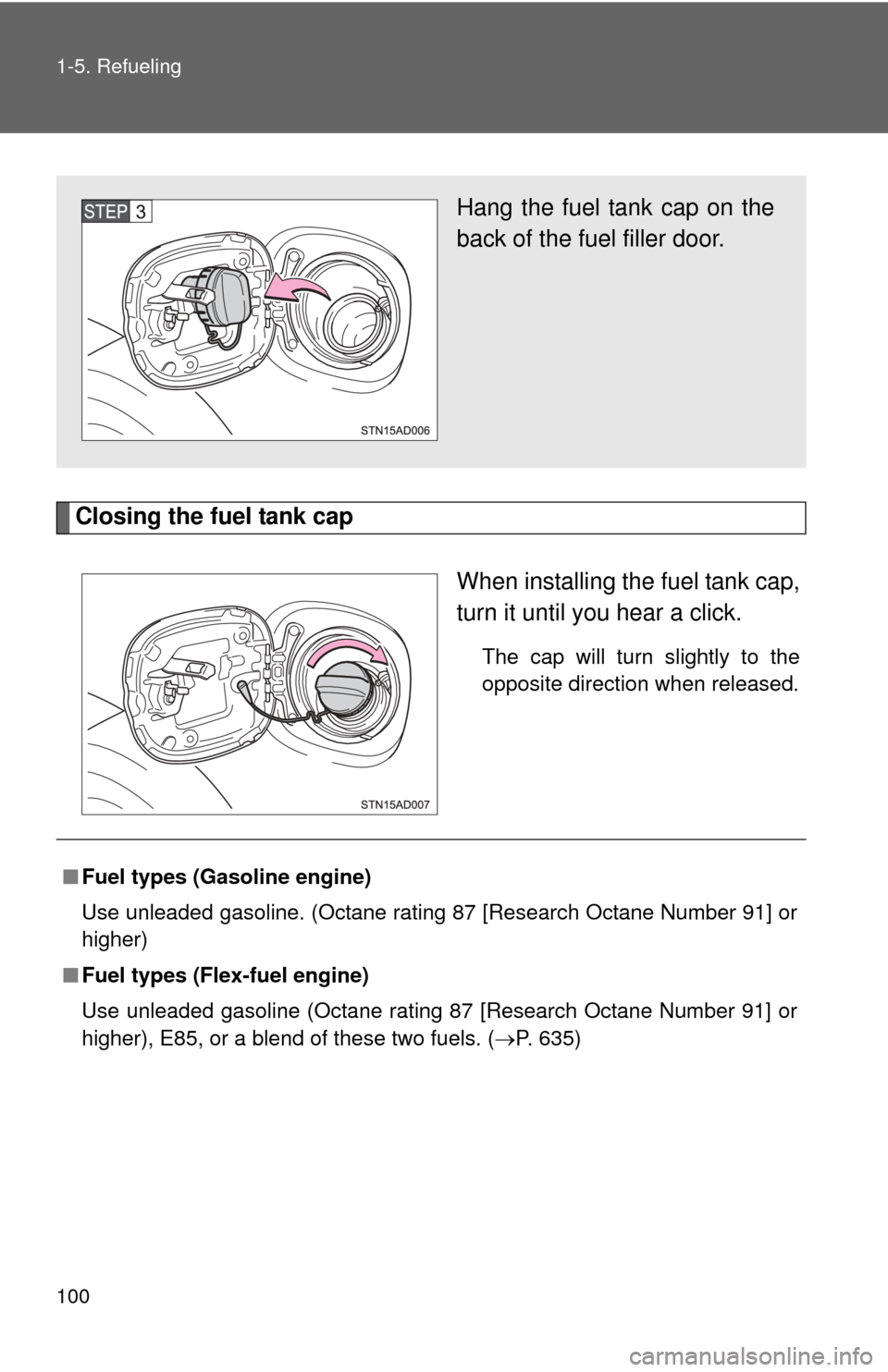
100 1-5. Refueling
Closing the fuel tank capWhen installing the fuel tank cap,
turn it until you hear a click.
The cap will turn slightly to the
opposite direction when released.
Hang the fuel tank cap on the
back of the fuel filler door.
■Fuel types (Gasoline engine)
Use unleaded gasoline. (Octane rating 87 [Research Octane Number 91] or
higher)
■ Fuel types (Flex-fuel engine)
Use unleaded gasoline (Octane rating 87 [Research Octane Number 91] or
higher), E85, or a blend of these two fuels. ( P. 635)
Page 149 of 688
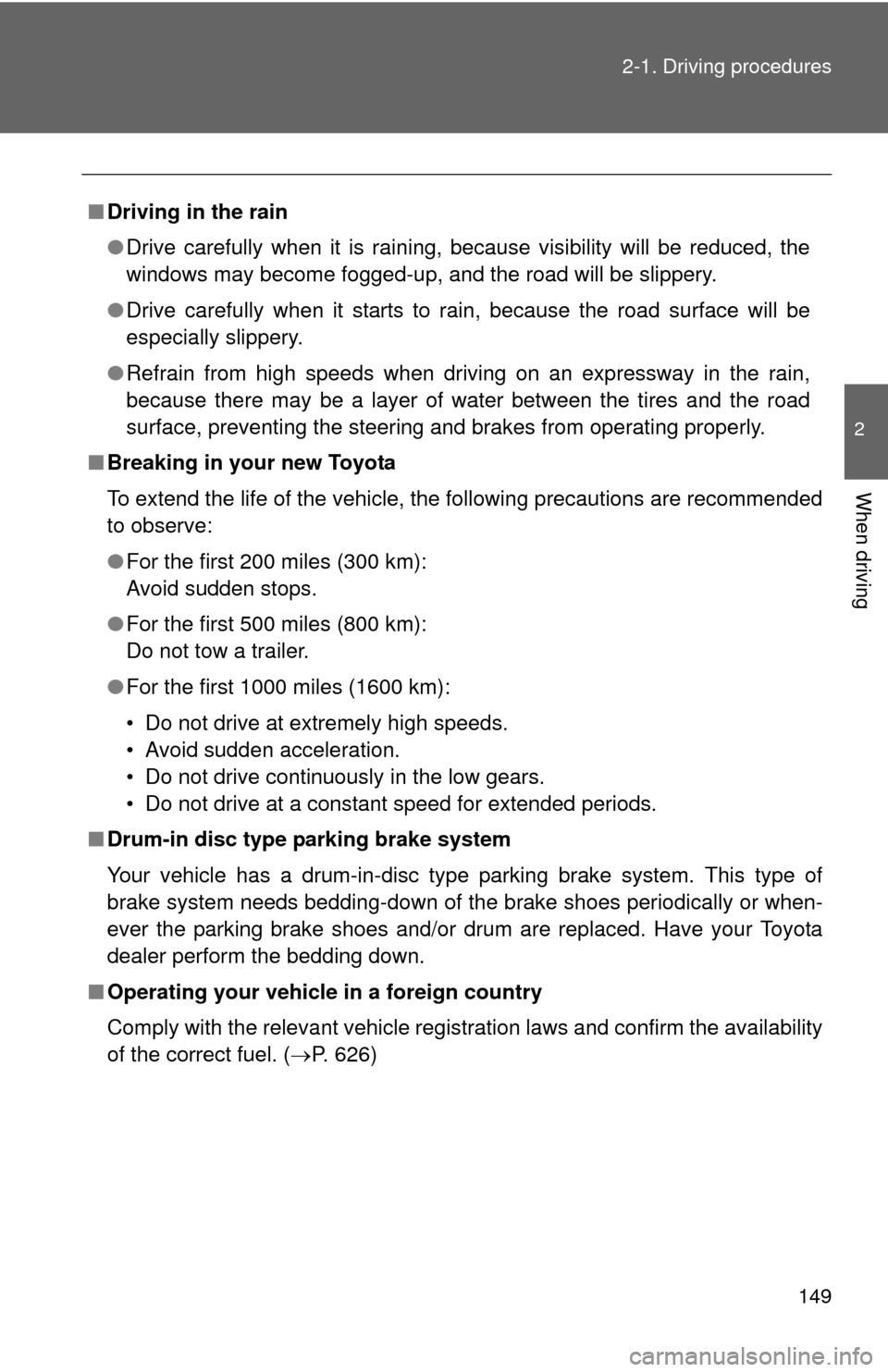
149
2-1. Driving procedures
2
When driving
■
Driving in the rain
●Drive carefully when it is raining, because visibility will be reduced, the
windows may become fogged-up, and the road will be slippery.
● Drive carefully when it starts to rain, because the road surface will be
especially slippery.
● Refrain from high speeds when driving on an expressway in the rain,
because there may be a layer of water between the tires and the road
surface, preventing the steering and brakes from operating properly.
■ Breaking in your new Toyota
To extend the life of the vehicle, the following precautions are recommended
to observe:
●For the first 200 miles (300 km):
Avoid sudden stops.
● For the first 500 miles (800 km):
Do not tow a trailer.
● For the first 1000 miles (1600 km):
• Do not drive at extremely high speeds.
• Avoid sudden acceleration.
• Do not drive continuously in the low gears.
• Do not drive at a constant speed for extended periods.
■ Drum-in disc type parking brake system
Your vehicle has a drum-in-disc type parking brake system. This type of
brake system needs bedding-down of the brake shoes periodically or when-
ever the parking brake shoes and/or drum are replaced. Have your Toyota
dealer perform the bedding down.
■ Operating your vehicle in a foreign country
Comply with the relevant vehicle registration laws and confirm the availability
of the correct fuel. ( P. 626)
Page 188 of 688
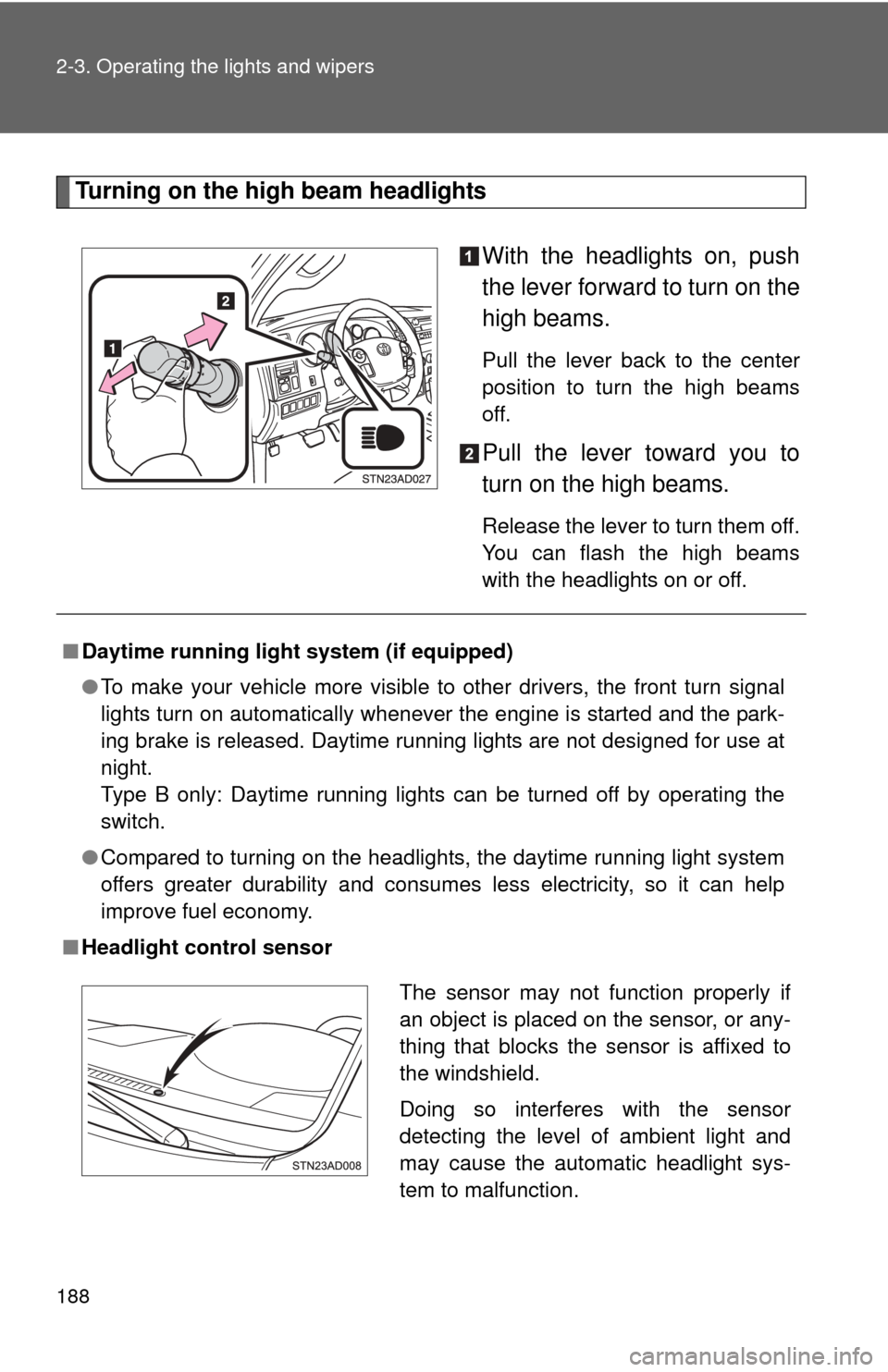
188 2-3. Operating the lights and wipers
Turning on the high beam headlightsWith the headlights on, push
the lever forward to turn on the
high beams.
Pull the lever back to the center
position to turn the high beams
off.
Pull the lever toward you to
turn on the high beams.
Release the lever to turn them off.
You can flash the high beams
with the headlights on or off.
■Daytime running light system (if equipped)
●To make your vehicle more visible to other drivers, the front turn signal
lights turn on automatically whenever the engine is started and the park-
ing brake is released. Daytime running lights are not designed for use at
night.
Type B only: Daytime running lights can be turned off by operating the
switch.
● Compared to turning on the headlights, the daytime running light system
offers greater durability and consumes less electricity, so it can help
improve fuel economy.
■ Headlight control sensor
The sensor may not function properly if
an object is placed on the sensor, or any-
thing that blocks the sensor is affixed to
the windshield.
Doing so interferes with the sensor
detecting the level of ambient light and
may cause the automatic headlight sys-
tem to malfunction.
Page 608 of 688

608
5-2. Steps to take in an emergency
If the engine will not star t
If the engine still does not start after following the correct starting
procedure ( P. 157) or releasing the steering lock (P. 158), confirm
the following points.
■ The engine will not start even when the starter motor oper-
ates normally.
One of the following may be the cause of the problem.
●There may not be sufficient fuel in the vehicle’s tank.
Refuel the vehicle. ( P. 9 9 )
Flex-fuel vehicles: The type of fuel may be different. When
refueling, add the same type of fuel, if available.
After adding a different type of fuel, the engine may run
roughly and driving performance may be reduced for a while
when the engine is first started. In this case, wait until the
engine runs normally.
● The engine may be flooded.
Try to restart the engine once more following correct starting
procedures.
● There may be a malfunction in the engine immobilizer system.
( P. 104)
■ The starter motor turns over slowly, the interior lights and
headlights are dim, or the horn does not sound or sounds at
a low volume.
One of the following may be the cause of the problem.
●The battery may be discharged. ( P. 612)
● The battery terminal connec tions may be loose or corroded.
Page 626 of 688
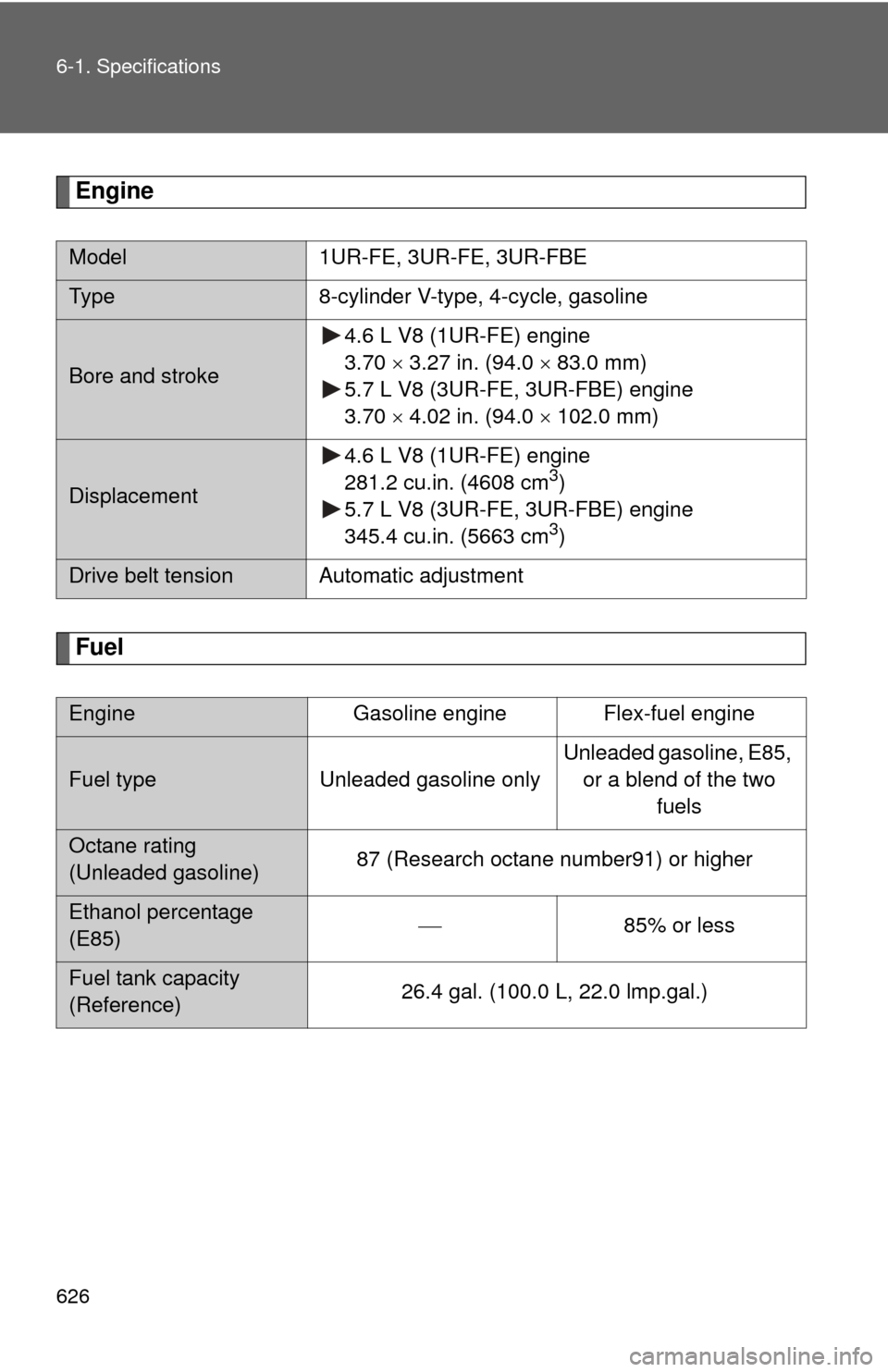
626 6-1. Specifications
Engine
Fuel
Model1UR-FE, 3UR-FE, 3UR-FBE
Type 8-cylinder V-type, 4-cycle, gasoline
Bore and stroke 4.6 L V8 (1UR-FE) engine
3.70
3.27 in. (94.0 83.0 mm)
5.7 L V8 (3UR-FE, 3UR-FBE) engine
3.70 4.02 in. (94.0 102.0 mm)
Displacement 4.6 L V8 (1UR-FE) engine
281.2 cu.in. (4608 cm3)
5.7 L V8 (3UR-FE, 3UR-FBE) engine
345.4 cu.in. (5663 cm
3)
Drive belt tension Automatic adjustment
Engine Gasoline engine Flex-fuel engine
Fuel typeUnleaded gasoline onlyUnleaded gasoline, E85,
or a blend of the two
fuels
Octane rating
(Unleaded gasoline) 87 (Research octane number91) or higher
Ethanol percentage
(E85)
85% or less
Fuel tank capacity
(Reference) 26.4 gal. (100.0 L, 22.0 lmp.gal.)
Page 637 of 688
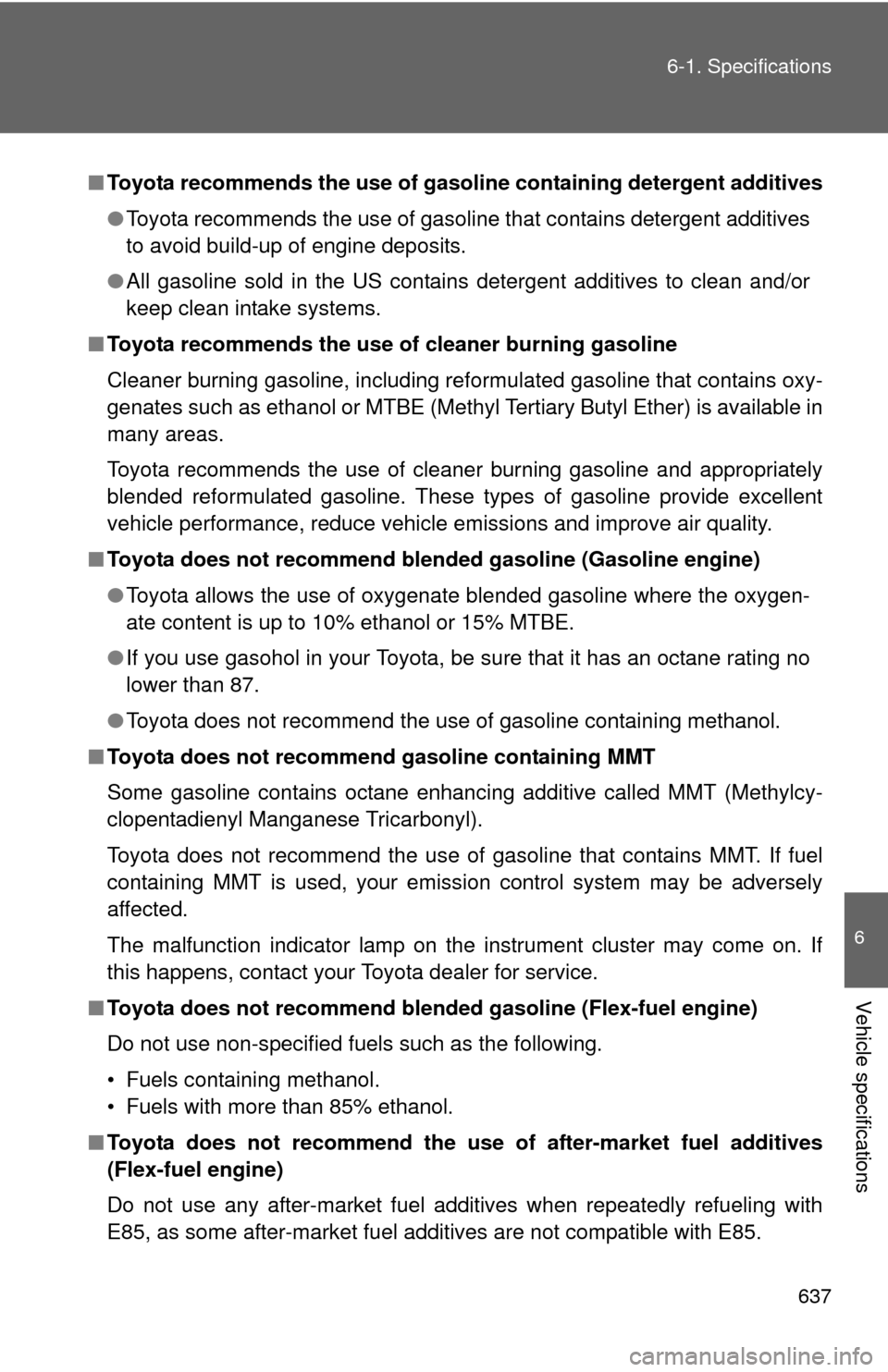
637
6-1. Specifications
6
Vehicle specifications
■
Toyota recommends the use of gaso line containing detergent additives
● Toyota recommends the use of gasoline that contains detergent additives
to avoid build-up of engine deposits.
● All gasoline sold in the US contains detergent additives to clean and/or
keep clean intake systems.
■ Toyota recommends the use of cleaner burning gasoline
Cleaner burning gasoline, including reformulated gasoline that contains oxy-
genates such as ethanol or MTBE (Methyl Tertiary Butyl Ether) is available in
many areas.
Toyota recommends the use of cleaner burning gasoline and appropriately
blended reformulated gasoline. These types of gasoline provide excellent
vehicle performance, reduce vehicle emissions and improve air quality.
■ Toyota does not recommend blended gasoline (Gasoline engine)
●Toyota allows the use of oxygenate blended gasoline where the oxygen-
ate content is up to 10% ethanol or 15% MTBE.
● If you use gasohol in your Toyota, be sure that it has an octane rating no
lower than 87.
● Toyota does not recommend the use of gasoline containing methanol.
■ Toyota does not recommend gasoline containing MMT
Some gasoline contains octane enhancing additive called MMT (Methylcy-
clopentadienyl Manganese Tricarbonyl).
Toyota does not recommend the use of gasoline that contains MMT. If fuel
containing MMT is used, your emission control system may be adversely
affected.
The malfunction indicator lamp on the instrument cluster may come on. If
this happens, contact your Toyota dealer for service.
■ Toyota does not recommend blended gasoline (Flex-fuel engine)
Do not use non-specified fuels such as the following.
• Fuels containing methanol.
• Fuels with more than 85% ethanol.
■ Toyota does not recommend the use of after-market fuel additives
(Flex-fuel engine)
Do not use any after-market fuel additives when repeatedly refueling with
E85, as some after-market fuel additives are not compatible with E85.
Page 638 of 688
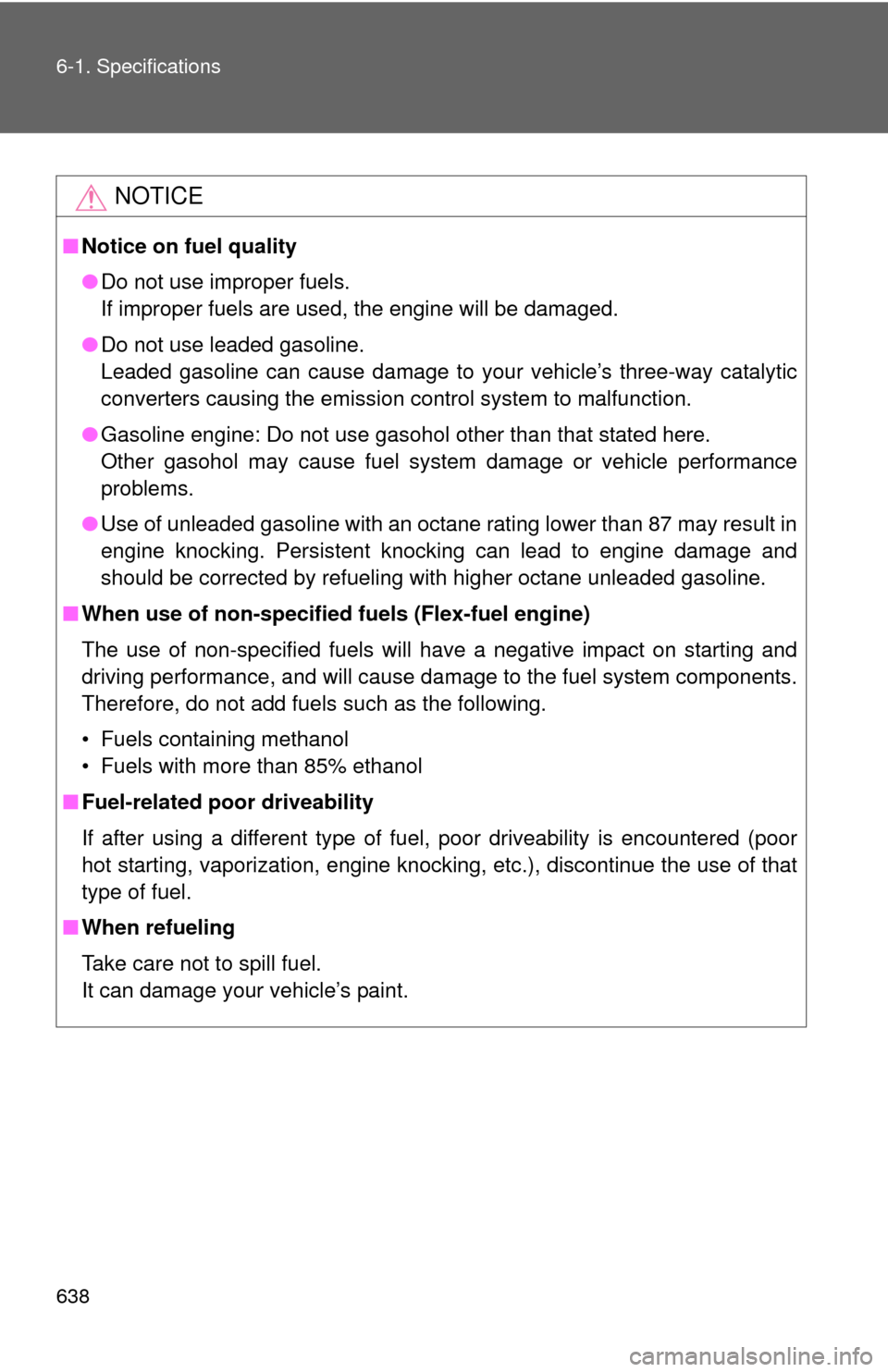
638 6-1. Specifications
NOTICE
■Notice on fuel quality
●Do not use improper fuels.
If improper fuels are used, the engine will be damaged.
● Do not use leaded gasoline.
Leaded gasoline can cause damage to your vehicle’s three-way catalytic
converters causing the emission control system to malfunction.
● Gasoline engine: Do not use gasohol other than that stated here.
Other gasohol may cause fuel system damage or vehicle performance
problems.
● Use of unleaded gasoline with an octane rating lower than 87 may result in
engine knocking. Persistent knocking can lead to engine damage and
should be corrected by refueling with higher octane unleaded gasoline.
■ When use of non-specified fuels (Flex-fuel engine)
The use of non-specified fuels will have a negative impact on starting and
driving performance, and will cause damage to the fuel system components.
Therefore, do not add fuels such as the following.
• Fuels containing methanol
• Fuels with more than 85% ethanol
■ Fuel-related poor driveability
If after using a different type of fuel, poor driveability is encountered (poor
hot starting, vaporization, engine knocking, etc.), discontinue the use of that
type of fuel.
■ When refueling
Take care not to spill fuel.
It can damage your vehicle’s paint.
Page 677 of 688
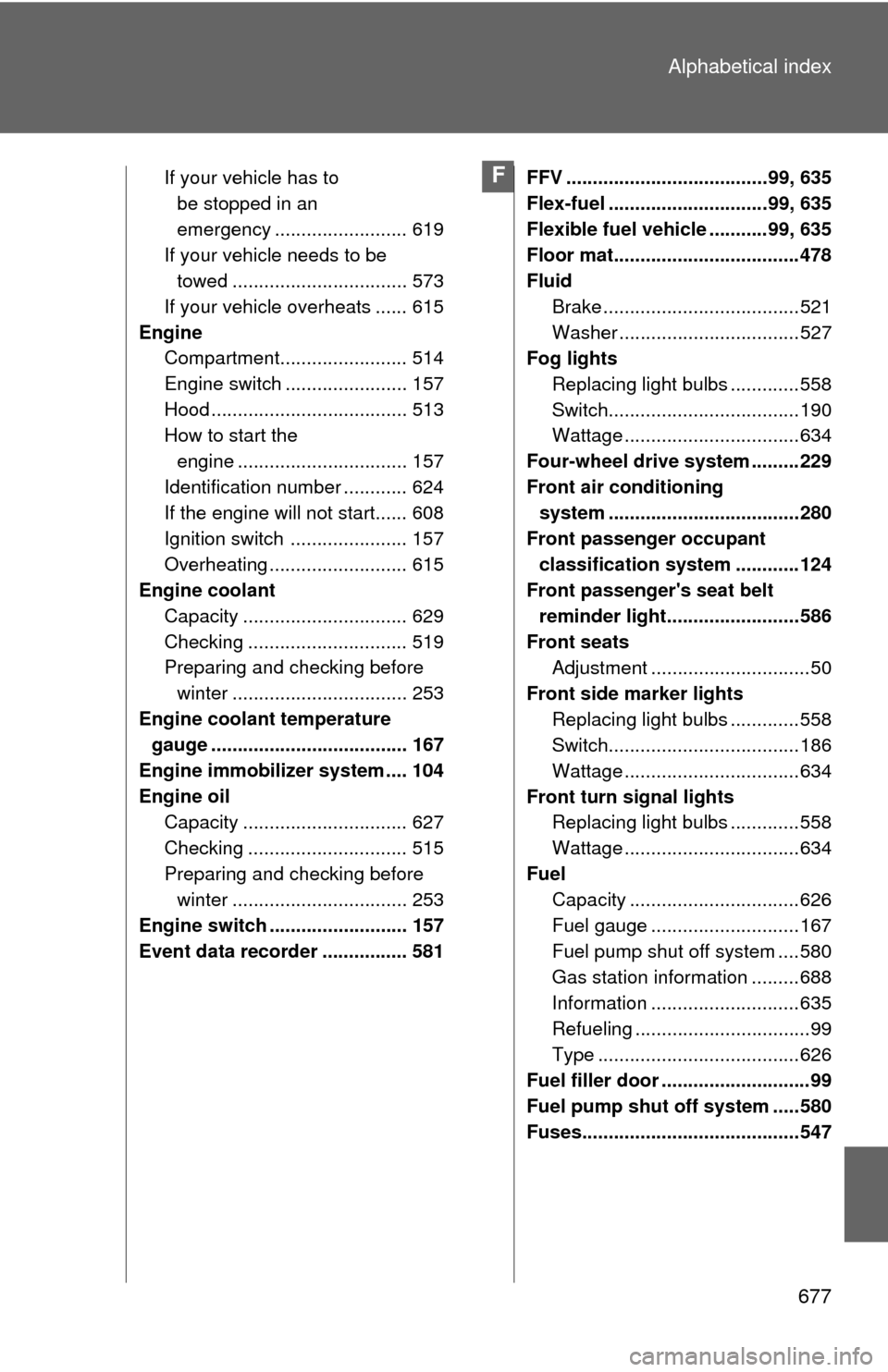
677
Alphabetical index
If your vehicle has to
be stopped in an
emergency ......................... 619
If your vehicle needs to be towed ................................. 573
If your vehicle overheats ...... 615
Engine Compartment........................ 514
Engine switch ....................... 157
Hood ..................................... 513
How to start the
engine ................................ 157
Identification number ............ 624
If the engine will not start...... 608
Ignition switch ...................... 157
Overheating .......................... 615
Engine coolant
Capacity ............................... 629
Checking .............................. 519
Preparing and checking before winter ................................. 253
Engine coolan t temperature
gauge ..................................... 167
Engine immobilizer system .... 104
Engine oil Capacity ............................... 627
Checking .............................. 515
Preparing and checking before winter ................................. 253
Engine switch .......................... 157
Event data recorder ................ 581 FFV ......................................99, 635
Flex-fuel ..............................99, 635
Flexible fuel vehicle ...........99, 635
Floor mat...................................478
Fluid
Brake .....................................521
Washer ..................................527
Fog lights
Replacing light bulbs .............558
Switch....................................190
Wattage .................................634
Four-wheel drive system .........229
Front air conditioning system ....................................280
Front passenger occupant classification system ............124
Front passenger's seat belt
reminder light.........................586
Front seats Adjustment ..............................50
Front side marker lights Replacing light bulbs .............558
Switch....................................186
Wattage .................................634
Front turn signal lights Replacing light bulbs .............558
Wattage .................................634
Fuel Capacity ................................626
Fuel gauge ............................167
Fuel pump shut off system ....580
Gas station information .........688
Information ............................635
Refueling .................................99
Type ......................................626
Fuel filler door ............................99
Fuel pump shut off system .....580
Fuses.........................................547F